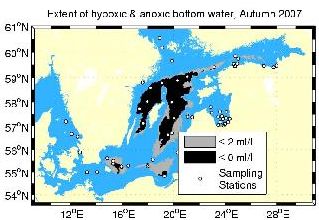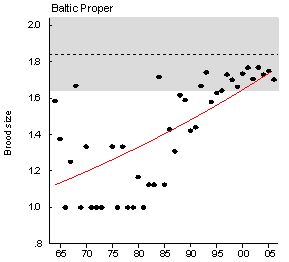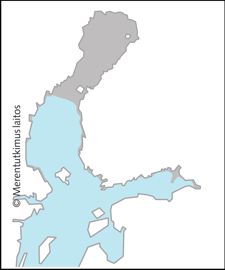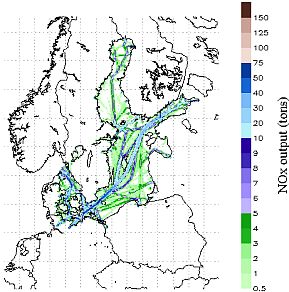HELCOM Indicator Fact Sheets for 2008
As the environmental focal point of the Baltic Sea, HELCOM, has been assessing the sources and inputs of nutrients and hazardous substances and their effects on ecosystems in the Baltic Sea for almost 30 years. The resulting indicators are based on scientific research carried out around the Baltic Sea under the HELCOM PLC, COMBINE and MORS monitoring programmes. During the past few years, HELCOM Indicator Fact Sheets have been compiled by responsible institutions around the Baltic and approved by the HELCOM Monitoring and Assessment Group for publication. The Indicator Fact Sheets for 2008 and 2007 are listed in the navigation menu on the left and older ones can be found in the Indicator Fact Sheet archive.Changing seasons
The sea surface temperature in 2007 was comparatively warm in the first half of the year with January, February, and April being the warmest months since 1990 in the entire Baltic Sea and during June in the Baltic Proper. The months of July, August, and September were below the long-term means, however. Consequently the ice season of 2007-2008 was very late, short and extremely mild in terms of ice extent. According the Russian Ice Service the ice season was the warmest during more than the 100-years period of observations. The largest ice cover – 49,000 km² – was reached as late as on the 24th of March and on the 25th May the Baltic Sea was ice free.
In terms of wave climate, January was clearly the roughest month at all the stations where measurements were made and the highest significant wave heights for the year were measured in the Gulf of Finland, the Northern Baltic Proper, Arkona basin and Skagerrak.
Life pulsates according to water inflows
The present state of the Baltic Sea is not only the result of anthropogenic pressures but is also influenced by meteorological conditions and hydrographic forces such as water exchange between the Baltic Sea and the North Sea. The inflow of waters from the Kattegat into the Baltic Sea during 2002-2003 terminated the stagnation period in the Baltic deep water which lasted since 1995. The period afterwards has been characterized by low inflow activities and except for in the southern Baltic, the stagnation period lasting since 2004-2005 is strengthening further.
 This stagnation period has resulted in a steady worsening of oxygen conditions in the deep basins of the Baltic Proper. In the South Eastern Baltic Proper, Western and Eastern Gotland Basins and Northern Baltic Proper, deep water salinity has increased, making the ventilation of these deep basins less likely.
This stagnation period has resulted in a steady worsening of oxygen conditions in the deep basins of the Baltic Proper. In the South Eastern Baltic Proper, Western and Eastern Gotland Basins and Northern Baltic Proper, deep water salinity has increased, making the ventilation of these deep basins less likely.
Meteorological conditions, including wind patterns and precipitation affect the inflow of water from the catchment area and the deposition of pollutants directly onto the sea. The total runoff to the Baltic Sea area shows no long-term trend for the period 1950 – 2007. On the other hand this time period is characterized by dry and wet periods lasting for a couple of years. In the last 10 years, the total inflow to the Baltic Sea has decreased from a top flow rate of over 17,500 m3/s in 1998 to less than 11,000 in 2003. In 2007, the flow of 13,707 m3/s was still below the mean.
The Baltic Sea continues to suffer the impacts of human activities
Baltic Sea habitats and species are threatened by eutrophication and elevated amounts of hazardous substances as a result of decades of human activities in the sea and its surrounding catchment area.
The inputs of some hazardous substances to the Baltic Sea have reduced considerably over the past 20 to 30 years, in particular discharges of heavy metals. A significant proportion of heavy metals enter the Baltic Sea via rivers or as direct waterborne discharges: 47% for lead, 78% for mercury and 87% for cadmium in 2005. The remaining share of inputs originates from emissions of heavy metals to the air that are subsequently deposited to the Baltic Sea. Dioxin emissions to the air from the Baltic coastal states have decreased by 22% during the period 1994-2006, whereas the net annual depositions of dioxins to the Baltic Sea during the same period decreased by up to 59%.
A range of anthropogenic activities contribute to the significant inputs of nutrient to the sea, which enter the sea via runoff, riverine input, through direct waterborne discharges or via atmospheric deposition. Although nutrient inputs from point sources such as industries and municipalities have been cut significantly, the total input of nitrogen to the Baltic Sea is still almost 900,000 tonnes per year, of which approximately 25% enters as atmospheric deposition on the Baltic Sea and 75% as waterborne inputs. The total input of phosphorus to the Baltic Sea in 2005 was ca 29,000 tonnes and entered the Baltic Sea mainly as waterborne input with the contribution of atmospheric deposition being only 1-5 % of the total. The main source of nutrient loads to the Baltic Sea is agriculture.The 2005 waterborne loads of nitrogen and phosphorus reported by HELCOM countries were mostly at the same level as in the previous year because the riverine flow was almost equal to the flow in 2004. Compared with the 10 year (1996-2005) average, both nitrogen (-5%) and phosphorus (-11%) waterborne loads in 2005 were lower, and most probably reflect the implementation of load reduction measures in the catchment area.
Annual emissions of nitrogen to the air from the HELCOM Contracting Parties were lower in 2006 than in 1995. Emissions from outside the Baltic Sea region add to the airborne nitrogen loads entering the Baltic, as do emissions from shipping. Nitrogen oxide emissions from Baltic Sea shipping were found to be of the same magnitude as the combined land-based emission sources of Finland and Sweden. Mainly because of interannual changes in meteorology, no significant temporal pattern in atmospheric deposition of nitrogen to the Baltic Sea and its sub-basins can be detected for the period 1995-2006. Nevertheless, annual deposition of oxidized, reduced and total nitrogen in 2006 was respectively 12%, 7% and 10% lower than in 1995.
Eutrophication intensifies phytoplankton blooms

A decrease in water clarity has been observed in all Baltic Sea sub-regions over the last one hundred years, with it being most pronounced in the Northern Baltic Proper and the Gulf of Finland. An increase in water transparency during the last 20 years has been detected in the Bornholm and Arkona Seas and in Kattegat and the Eastern Gotland Basin the decreasing trend has ceased during the past 10 to 15 years with the water transparency remaining at about the same level.
In 2008, the concentrations of dissolved surface nutrients near the surface increased until March-April in the Gulf of Finland and until February in the Northern Baltic Proper and the Bornholm Sea. This is considerably later than during the previous two years.
Dissolved inorganic nitrogen levels remain below the 1993 – 2002 average in the offshore Baltic. The spatial distribution of inorganic (primary bio-available) nutrients (in surface waters, during winter) highlights problem areas, and shows the availability of nutrients for the spring bloom. Changes in the spatial distribution may indicate changes in the hydrography or the effect of remedial works.
No rising trend can be detected in spring blooms from 1992 to 2008 in the Gulf of Finland, the northern Baltic Proper or the Arkona Basin and in 2008 the spring bloom intensity in these areas was close to the previous year. Cyanobacterial blooms in the summer of 2008 were concentrated to the month of July in the Baltic Proper, and to the end of August in the Bothnian Sea. The bloom culminated during the warm and sunny period 24 July to 1 August, when satellite images revealed almost the entire Baltic Sea to be coloured green. The cyanobacteria bloom index shows, that in 2007 the toxic Nodularia spumigena rank based abundance was highest ever recorded and twice as high as in the previous year, while Aphanizomenon flos-aquae showed slightly higher values in the year 1999. In July 2008 phytoplankton biomass was higher than the long term average in all sea areas.
The satellite-derived chlorophyll-like pigments in the Baltic Sea are clearly higher than in the Skagerrak and North Sea. The chlorophyll a concentration* exceeded 3mg m-3 for more than 60% of the days during the summer period 2006 (June-September) in the Arkona, Bornholm, Easter Gotland and Northern Gotland Basins and Gulf of Riga and Finland.
Bacterioplankton growth rate* indicates the rate of oxygen consumption that may lead to oxygen deficiency in the water column when the oxygen supply is exceeded. The bacterioplankton growth rate in the deep waters of the Gulf of Bothnian suggests at least good conditions in terms of oxygen consumption during the past decade because corresponding oxygen consumption was low enough to allow sufficient replenishment of oxygen by advection of surface water.
Annual sedimentation dynamics*** in the Central Baltic can be separated into three distinct periods which can be allocated to different drivers of pelagic biomass production. Winter surface accumulated nutrients are used by spring bloom algae, summer mixed layer biomass production is governed by nitrogen fixing cyanobacteria and increased water mass convection in autumn finds its response in an autumn bloom of a mixed algal community. All three surface production peaks are reflected in respective transport events of organic matter to the sediment. Annual integrated rates for sedimentation of organic matter*** in the Gotland Sea have not show significant trends between 1995 and 2003 although the major Baltic inflow event in January 2003 exerted a pronounced effect on both surface biomass production and mode of vertical particle transport resulting in an overall increase of organic carbon supply to the sediment by a factor of four.
Hazardous substances still persistent in the marine environment

The health status and reproductive ability of top predators such as grey seals and white-tailed sea eagle also reflect the state of the Baltic environment. Although the reproductive health investigated in grey seals has improved since the middle of 1980s and the population is increasing at about 8% a year since 1990, the prevalence of intestinal ulcers has increased significantly in investigated juveniles and the mean blubber thickness has decreased significantly in investigated by-caught juveniles.
Strong relationships have been found between white-tailed sea eagle reproductive ability and concentrations of DDTs and PCBs in their eggs. Reproduction in the Baltic eagle population in the 1970s was reduced to a fifth of the pre-1950 population size. Following bans of DDT and PCB during the 1970s around the Baltic, eagle productivity began to recover in the 1980s and since the mid-1990s is largely back to a pre-1950 level. On the coast of the Bothnia Sea, nestling brood size remains below the pre-1950 level and the occurrence of dead eggs is significantly higher than in the Baltic Proper and Bothnian Bay, indicating a possible impact from other contaminants.
Concentrations of contaminants in fish vary according to substance, species and location. Whereas there is no common trend in mercury concentrations*, in general, the concentrations of cadmium*, lead*, PCBs and lindane* have decreased. The concentrations of TCDD-equivalents (dioxins) in guillemot eggs show an overall significant decreasing trend, however, not during the recent 15 years. A significant increasing trend can be seen in the Bothnian Bay for TCDD-equivalents in herring muscle from 1990-2006. As for the concentrations of flame retardants HBCD, a significant increase of about 3% per year can be observed in Guillemot eggs while no trend can be seen for HBCD in herring muscle during the monitored time period, 1999-2006/7.
The levels of perfluorooctane sulfonate (PFOS) in Guillemot eggs in the early 2000s have been found to be 25-30 times higher when compared to levels in the late 1960s. No trend can be observed during the last ten year, but, due to the long environmental half-live of PFOS it cannot be expected that levels will decrease rapidly.
Overall the levels of radioactivity in the Baltic Sea water and biota have shown declining trends since the Chernobyl accident in 1986, which caused significant fallout over the area. In general, the discharges of radionuclides from local nuclear power plants into the Baltic Sea have shown decreasing trends during the last decade and contribute less than 1% of total inputs of radioactivity into the Baltic Sea. Radioactivity is now slowly transported from the Baltic Sea to the North Sea via Kattegat. The amount of caesium-137 in Baltic Sea sediments however has remained largely unchanged, with highest concentrations in the Bothnian Sea and the Gulf of Finland.
Ecosystem effects
The biodiversity of the Baltic Sea is affected by a wide range of anthropogenic as well as natural pressures. Variables such as climate-induced changes in temperature and salinity, fishing pressure, as well as variations in bottom water oxygen conditions (climate and eutrophication induced) all have significant impacts on ecosystem structure.
Despite a lack of consistency, high water temperatures during growth seasons in recent years have possibly affected coastal fish communities in Bothnian Sea. This is reflected as an increased recruitment success and/or increased individual growth rate of dominating, warm water dwelling, species, e.g. perch (Perca fluviatilis) and roach (Rutilus rutilus). Furthermore, the effects of changes in fishing pressure were observed in Gulf of Riga and in southern Baltic Proper. In the Gulf of Riga a high exploitation rate of piscivorous fish during mid 1990’s was clearly recognised and in the Baltic Proper, flounder (Platichthys flesus), has increased during the period possibly due to population recovery after a previous high exploitation rate.
Macrobenthic communities*** have also been severely degraded by the increased eutrophication throughout the Baltic Proper and the Gulf of Finland and are below the long-term averages. Populations of the amphipod Monoporeia affinis have crashed in the Gulf of Bothnia and the invasive polychaete Marenzelleria viridis has spread.
Impacts of shipping on the marine environment

* These Indicator Fact Sheets have not been updated since 2007.
**These Indicator Fact Sheets have not been updated since 2006.
***These Indicator Fact Sheets have not been updated since 2005.
Information on the long-term varaitions in the Baltic marine environment can be found in:
Atmospheric Supply of Nitrogen, Lead, Cadmium, Mercury and Dioxins/Furans to the Baltic Sea in 2006 (2008)
Atmospheric Supply of Nitrogen, Lead, Cadmium, Mercury and Dioxins/Furans to the Baltic Sea in 2005 (2007)
Climate Change in the Baltic Sea Area - HELCOM Thematic Assessment 2007 (2007)
Heavy metal pollution to the Baltic Sea in 2004 (2007)
Atmospheric Supply of Nitrogen, Lead, Cadmium, Mercury and Dioxins/Furans to the Baltic Sea in 2004 (2006)
Assessment of Coastal Fish in the Baltic Sea (2006)
Nutrient Pollution to the Baltic Sea in 2000 (2005)
Airborne nitrogen loads to the Baltic Sea (2005)
Evaluation of transboundary pollution loads (2005)
Dioxins in the Baltic Sea (2004)
The Fourth Baltic Sea Pollution Load Compilation (PLC-4) (2004)
The Baltic Marine Environment 1999-2002 (2003)
Radioactivity in the Baltic Sea 1992-1998 (2003)
Fourth Periodic Assessment of the State of the Marine Environment of the Baltic Sea Area, 1994-1998 (2003)
Fourth Periodic Assessment of the State of the Marine Environment of the Baltic Sea, 1994-1998; Executive Summary (2001)
Links to 2008 indicator fact sheets:
Water exchange between the Baltic Sea and the North Sea, and conditions in the deep basins
Hydrography and oxygen in the deep basins
Total and regional Runoff to the Baltic Sea
Water transparency in the Baltic Sea between 1903 and 2008
Wave climate in the Baltic Sea 2007
Development of sea surface temperature in the Baltic Sea in 2007
Waterborne loads of nitrogens and phosphorus to the Baltic Sea in 2006
Nitrogen emissions to the air in the Baltic Sea area
Emissions from the Baltic Sea shipping (NEW)
Atmospheric nitrogen deposition to the Baltic Sea during 1995-2006
Spatial Distribution of the winter nutrient pool
Cyanobacterial blooms in the Baltic Sea
Unusual phytoplankton event during winter-spring 2007-2008
Waterborne inputs of heavy metals to the Baltic Sea
Atmospheric emissions of heavy metals in the Baltic Sea region
Atmospheric depositions of heavy metals on the Baltic Sea
Atmospheric emissions of PCDD/Fs in the Baltic Sea region
Atmospheric depositions of PCDD/Fs on the Baltic Sea
Trace metal concentrations and trends in Baltic surface and deep waters , 1993-2007
TCDD-equivalents in herring muscle and guillemot egg
PCB concentrations in fish muscle
Hexabromocyclododecane (HBCD) concentrations in herring muscle and Guillemot egg
Perfluorooctane sulfonate (PFOS) concentrations in fish liver and guillemot egg (NEW)
Predatory bird health - white-tailed sea eagle (NEW)
Health assessment in the Baltic grey seal (Halichoerus grypus) (NEW)
Temporal development of Baltic coastal fish communities and key species
Liquid discharges of Cs-137, Sr-90 and Co-60 into the Baltic Sea from local nuclear installations
Total amounts of the artificial radionuclide caesium -137 in Baltic Sea sediments
Concentrations of the artificial radionuclide caesium-137 in Baltic Sea fish and surface waters
The recent aquatic invasive species American comb jelly Mnemiopsis leidyi in the northern Baltic Sea
Last updated: 27 January 2009



